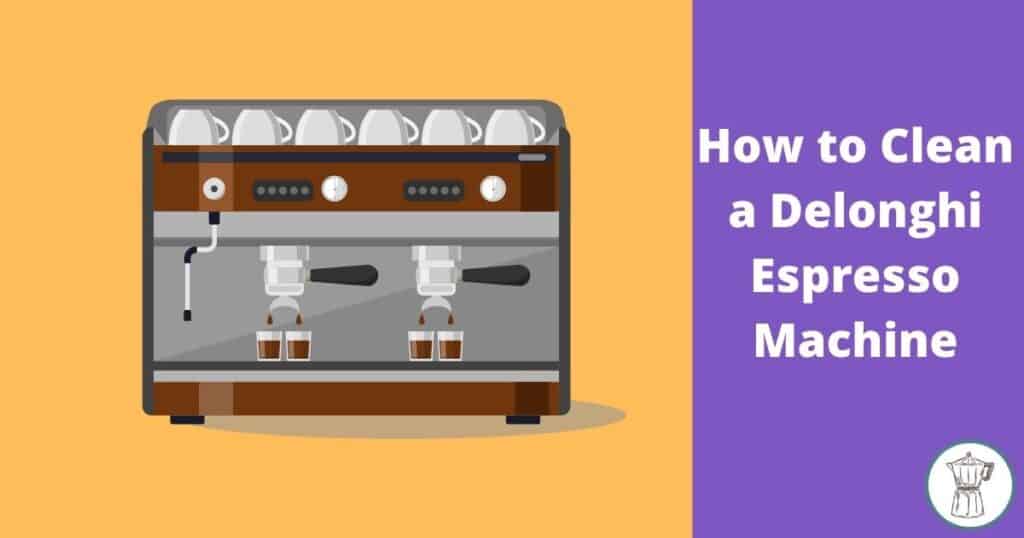Do you know how to clean a Delonghi Espresso Machine?
The other day I flew to Prague to visit my sister and explore this fantastic city. She owns a Delonghi espresso machine and she asked me to help her clean the machine properly. Stick around, in this article I’m going over how to clean a Delonghi espresso brewer and share espresso brewing tips as we go.
Let’s get straight in.
Read your Delonghi’s manual
I can imagine very few people actually do this.
Let’s be honest here, who reads the manual of the coffee machine?
But if you want to keep your machine as clean as possible and brew great coffee every single time, it’s wise to have a read of the manual.
It won’t take you a while; skim through the sections and pay attention to the key parts of your Delonghi. This is going to help you when you dismantle it to thoroughly clean it.
Clean your machine after each use
This is going to save you valuable time.
If you spend 5 minutes after brewing to clean your machine, cleaning thoroughly your machine it’s going to be easier each time.
Let’s assume that you don’t clean your machine each time after you’re done with coffee making. Coffee residue is going to be built on the inside of your machine and this will give you a hard time to thoroughly remove all the used coffee grounds.
Instead, if you clean your machine each time you brew coffee, you’ll prevent coffee from building huge amounts of residue on the inside.
This little extra effort will pay off long term.
How to clean a Delonghi espresso brewer step by step
Let’s go over the steps needed to clean your Delonghi espresso.
What you’ll need
- Hot water
- Detergent (mild preferably)
- Kitchen roll
- A little brush (even a toothbrush will do)
- A dry cloth
7 easy steps on how to make your brewer look shiny again
Here are the steps you need to follow to clean your Delonghi:
- Step1 – take off the portafilter and drip tray: Start by removing the portafilter and drip tray of your machine. Make sure you remove the coffee grounds from the portafilter (if the puck is stuck in the portafilter read this guide on how to remove a stuck puck, link)Put them in the sink and give them a proper good wash with soap to get rid of used coffee grounds and marks. Once you rinse the drip tray off, put it on the side upside down to dry out.
- Step 2 – sink the portafilter in water and vinegar: Coffee residue and oils are often stuck on the portafilter and it’s wise to sink it in a mix of hot water and vinegar (I personally use white vinegar and go for every 95 ml of water I add 5 ml of vinegar) for about 10-12 hours and then give it a wash with soap, rinse it off and leave it on the side to dry out.
- Step 3 – fill the water tank with water and vinegar: why is this important? If you haven’t cleaned your machine for quite some time it means hard water minerals have been built on the inside of your machine. And why does that matter? The odds are that it will spoil the taste of your coffee over time. It’s better to clean it with a mixture of water and vinegar to get rid of all those hard minerals.
- Step 4 – use a cleaning tablet: It’s obvious isn’t it. You have to use coffee grounds to make coffee with your Delonghi, meaning that somewhere on the inside of your machine coffee residue is stuck and turns your coffee bitter and sour. Remove them by using a coffee cleaning tablet which you can buy online. Find one that is compatible with Delonghi (like the one in the link above) and run 3-5 cycles to thoroughly clean your machine.
- Step 5 – clean the milk frother: This bit is going to make a whole lot of difference to your machine. An espresso machine froths milk at a high temperature (140-155F) and let’s be honest… milk in coffee goes so well. Who doesn’t like a latte or a cappuccino or even a macchiato? But milk is high in protein which makes it stick to the inside of the wand and this stuck milk spoils your coffee; it gets burned and affects the taste of your brew. I can’t stress how vital it is to clean the wand properly. Take it off and put it in a mixture of hot water and vinegar for about 12 hours. Or look for a milk wand solution – there are plenty of them online. It will cost you about 10 bucks but it’s worth it.
- Step 6 – clean the water tank: Remove it from the machine and use soap and water to clean it properly. Here’s the thing: if you don’t rinse it well enough, the odds are it will keep some of this soap and your coffee might have some extra bubbles next time (just kidding). Make sure you rinse it well with plenty of water.
- Step 7 – clean the outside surface: You can’t leave the outside surface looking dirty, can you? That’s an easy one: dip a dry cloth into a bowl with hot water and then go over the surface of your machine. Done? Cool, wipe it with kitchen roll and you’re good to go.
How often should I clean my machine?
It depends.
The question should be how many espressos do you brew every day on average? If you brew 1-2 per day, I suggest you clean your machine thoroughly once every 30-45 days. But if you’re a coffee addict and brew 4-5 (or more) shots every day then (you guessed it) you have to clean it more frequently.
Another way to approach this question is to look for signs.
What do I mean by ‘signs’?
Does your machine make unusual sounds while brewing lately? Is there more coffee residue in your cup than it used to be? Does your coffee taste more bitter the last few times you used it?
These are all signs that your machine needs cleaning.
Can I use vinegar to clean my Delonghi espresso machine?
Yes you can. In fact, vinegar (preferably white) is a great way and inexpensive to clean any coffee machine. Use it for descaling your machine to remove hard minerals of water or to clean the outside surface and get rid of coffee marks.
Why does everyone say to go for white vinegar?
The difference is minor: white vinegar doesn’t leave marks of its colour on the surface of your coffee machine. If you use white no one can tell you used vinegar to clean your coffee machine.
Let’s wrap it up
Do you now know how to clean a Delonghi espresso machine? I hope so, cleaning your coffee machine is boring – no one likes it but it will extend the lifespan of your machine, meaning you won’t spend any money in the near future for a new coffee machine. Which is a good thing. Think about it…

- How to Remove Coffee Stains From Countertop The Easy Way - December 21, 2023
- Can You Reuse Coffee Grounds in French Press? Truth Inside - December 12, 2023
- Can Expired Coffee Creamer Make You Sick? 3 Ways to Find Out - December 9, 2023
